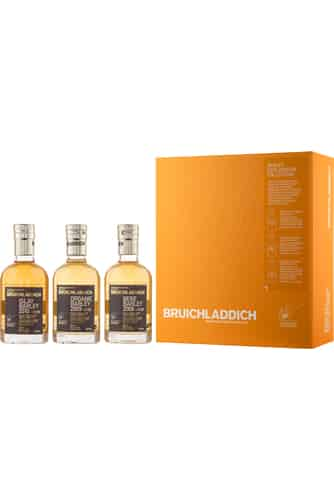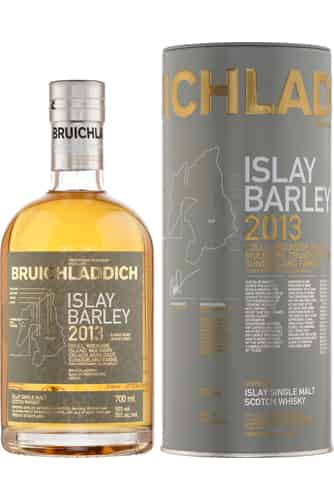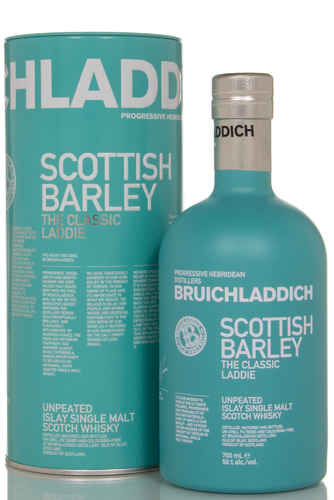Bruichladdich
Sorry, we didn't find anything. Please try changing your search criteria.
Bruichladdich History
Ah Bruichladdich, a fine distillery with a deceptive name. I was once in a bar, when a drinker of good taste ordered a "Brook Laddy" to which the barman replied "we don’t stock that American rubbish". Oh dear. In fact, Bruichladdich can be pronounced broo-ee-clah-dee and brook-lad- dee depending one’s accent, and the word comes from the Gaelic for "stony shore". Luckily for us, the whisky retains nothing of the roughness that the name suggests, and it is certainly one of the great Islay drams.
Bruichladdich has always been a rather forward thinking distillery (they describe themselves as "Progressive Hebridean Distillers"), and whereas many Islay distilleries grew up from illegal sidelines on farms, Bruichladdich was purpose-built in 1881 by three Harvey brothers- a distiller, an engineer and a businessman. It was one of the first buildings in the UK to use concrete. Now, the distillery is progressive in another way: locally sourcing its ingredients, with all its barley coming from Scotland, and a quarter from Islay. They’ve also been champions of organically produced whisky, and specialist grains such as the ancient Bere barley. In addition to all of this, and to the great joy of whisky aficionados, all Bruichladdich expressions are non-chill-filtered, and naturally coloured- free of caramel colouring additives.
Returning to the barley, Bruichladdich purchase their malted grains from Bairds of Inverness, who in turn malt and dry it in a saladin box for a period of 5 days. Now, this is where Bruichladdich becomes particularly interesting. The method of drying the malted barley is extremely significant to the eventual taste of the whisky; distilleries that produce unpeated whisky use a "hot air" method of drying, whilst distilleries that produce peated whisky tend to blast it with peat smoke early on, before finishing the drying with hot air. Bruichladdich distillery produces three types of single malt: "Bruichladdich", which is unpeated, and dried with hot air; "Port Charlotte", which is heavily peated; and "Octomore", which is super-heavily peated. The latter two are dried solely over peat smoke for several days, giving them their extremely peaty qualities.
Bruichladdich, whilst progressive, has a strong sense of history, and it is perhaps for this reason they continue to use the same mill they did in 1913. The Boby Mill grinds the malted barley to a grist, which is then transferred to the mashtuns for "mashing". Bruichladdich is unusual as it uses an open, wooden mashtun, one of only a few in existence. Here water from Bruichladdich Loch is added to the mix and drained repeatedly, which releases the sugars from the malt, giving that hearty cereal sweetness that defines single malt whisky. Ever-aware of their position as a part of Islay, Bruichladdich gives the porridge-like grainy by-product to the cattle at Octomore Farm. The liquid produced is known as "wort", and rather than an embarrassing growth on your history teacher’s nose, this is a sweet liquid that marks the beginning of whisky as an alcoholic drink.
Wort is transferred to into huge tuns known as washbacks, ready for fermentation. Bruichladdich, again showing a historical appreciation, continues to use traditional wooden washbacks under their principle of "minimal intervention". Fermentation occurs when yeast is added, and begins to convert sugar into alcohol. Bruichladdich uses two yeast strains: Mauri and Kerry, each of which converts at a different rate and temperature. This creates a strong barley beer, but fermentation halts when ABV reaches 7%- as the yeast can no longer transform sugar. This process creates the base for the spirit that becomes whisky, so it cannot be overlooked- it is crucially important to the flavours of the malt whisky. Once 7% has been reached, it’s time to running the stills, as the beer is ready to be distilled!
From there, the "wash" as it is now known, is distilled in two wash stills. These stills are heated by internal steam coils, and (without boiling the wash) the alcohol is evaporated carefully. It is then condensed in a water cooled device. This liquid runs in at about 20% and is known as "low wines", and we finally have something that is beginning to approach whisky. From here the low wines are transferred to spirit stills, where they are distilled again, finally producing the new-make Scotch spirit (coming in at 70%!) that will become whisky. Bruichladdich’s pot stills are remarkable, as they are extremely tall with very narrow necks. This is said to produce the fruity, elegant whisky that has defined the distillery, and (they claim) makes for a purer whisky. Bruichladdich also owns one of two operational "Lomond still"- named "Ugly Betty"- this is a strange, multi-levelled still that allows production of several spirits at once, and they use this to produce their Islay-based gin, "The Botanist".
Of course at this point, were you to see the whisky, to smell it and to taste, you would think it was an extremely strong, barley vodka. It is only through maturation that this spirit can really transform and become the Scotch we know and love. Bruichladdich has 14 warehouses, all of which are situated around Loch Indaal, a sea Loch in Islay. This seaside environment gives Bruichladdich whisky some of its more maritime notes. In modern times, Bruichladdich has become known for its wide variety of cask finishes and maturations; including high-end Bordeaux, Brandy, Saunternes and Sherry casks. Once in the barrel, all the whisky needs is time and a close eye.
Time has its way with us all, and Bruichladdich is no exception, as the distillery has a rather spotty history. From its founding by the Harvey brothers in 1881, Bruichladdich was mothballed for the first time in 1929, nine years late it was sold to a group of Americans after William Harvey’s death. This sale was the first of many, and the sales history reads like a who’s-who of important blenders and whisky companies. The Americans in turn sold it to Ross & Coulter Ltd in 1952, who sold it to A. B. Grant in 1960. After eight years, Bruichladdich was sold to Invergordon Distillers, who left their mark by doubling the stills from two to four. In 1975 JBB/Whyte & MacKay purchased the distillery, and after a 20 year period of stability it was mothballed again in 1995. The new millennium marked the distillery’s revival and turnaround in fortunes. A consortium of shareholders, led by independent bottler and wine merchant Mark Reynier purchased the distillery, and recruiting the help of veterans such as Jim McEwan, they managed to restart production in 2001. In the time it took to mature this spirit for sale, the owners made clever use of old stock, re-casking where necessary, to re-establish the brand. Finally, in mid-2012, it was announced that the European drinks giants Remy Cointreau had acquired Bruichladdich for just shy of £60million.
Bruichladdich Currently Offers
-
Unpeated
- The Classic Laddie- this is Bruichladdich’s entry level malt, and represents the signature, unpeated distillery style. All barley used is grown in Scotland. This No Age Statement whisky replaced the sorely-missed Laddie Ten, but it remains an excellent dram.
- Bere Barley 2008- this is whisky made with an ancient strain of Barley, harvest on the northern Scottish Isle of Orkney.
- Organic Scottish Barley- as the name suggests, all the barley sourced for this whisky is organic and from the Scottish Mid Coul Farm, Mains of Tullibardine Farm and Coulmore farm.
- Islay Barley 2007- All the barley for this whisky was grown on Islay itself, at Rockside farm.
- 23 Year Old 1990 Black Art 4.1- This is Bruichladdich’s premium malt and it is magnificent. A great variety of casks and finishes were used in this whisky, but the recipe specifics are unknown to all but the creator, Jim McEwan.
-
Heavily Peated
- Port Charlotte Scottish Barley- heavily peated whisky made with 100% Scottish barley and matured in casks selected by Jim McEwan.
- Port Charlotte Islay Barley 2008- barley for this whisky came from six farms on Islay, and it is peated to 40 parts per million (ppm).
-
Ultra Heavily Peated
- Octomore 6.1 5 Year Old Scottish Barley- peated to 167 ppm, this is one of the peatiest Scotches around. The barley used for this is 100% Scottish.
- Octomore 6.3 Islay Barley- All the barley for this whisky comes from Octomore farm itself. This is peated at a huge 258 ppm, making it peatiest whisky in ppm available for sale.
Noteable Releases
Sadly now restricted to travel retail only, the wine finished (marked by .2 after the batch number) Octomores are some of the finest and most complex peated whiskies available. The early batches of Black Art, Octomore and Port Charlotte are cult whiskies and now as rare as unicorns; if you spot one, buy it. Bruichladdich Cuvees and Golder Still are thought of as some of finest whisky produced by this distillery and, again, are extremely rare.
Did you know?
- The distillery has a relatively large staff of around 60- this is partly because it has moved to full production- meaning that whisky is brewed, distilled, matured and bottled all on site.
- The Octomore line of whiskies is some of the peatiest ever made.
- The distillery has a principle of "minimal intervention", meaning they endeavour to change as little as possible about the distilling process.
- As such much of the equipment that they use dates back to Victorian times.
- Bruichladdich is built on a hill, using gravity to efficiently transport liquid from part of the process to another. The only pumping that occurs is when the whisky is casked.
- No part of the whisky production is computerised, which also accounts for the larger staff.
- Bruichladdich was involved in a minor, and deeply surreal, diplomatic incident in 2003 when webcams showing feeds of Bruichladdich’s century old equipment was monitored by American Military intelligence, as the process creating whisky is very similar to the one used to create chemical weapons. According to the spy, codenamed Ursula, a few "tweaks" could result in the creation of Weapons of Mass Destruction. A spokesperson for the Defence Threat Reduction Agency said: "The United States is part of the Chemical Weapons Convention. That includes monitoring and visiting commercial facilities where they would be able to make chemical weapons." To commemorate the event, Bruichladdich did produce two batches of WMDs- that is, Whisky of Mass Destruction.





